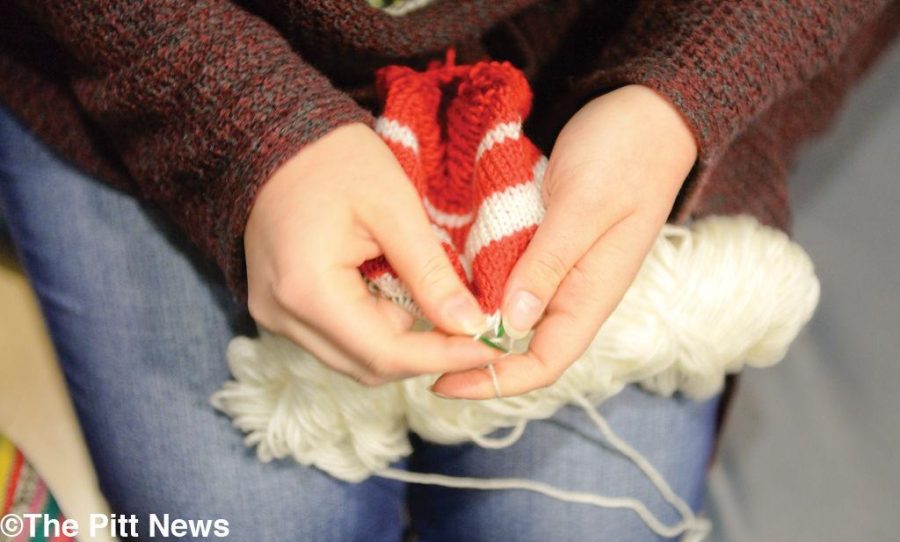Pitt students sell handmade goods on Etsy
February 19, 2015
There’s something inherently old-fashioned about knitting and craftsmanship, but that hasn’t stopped students from selling their own handmade goods on the web.
Anyone can easily sell their handmade goods on Etsy, an online marketplace for creative entrepreneurs that was founded in Brooklyn, New York City in June 2005 and has since accumulated approximately 43.9 million members and 1.2 million active shops. Some Pitt students create their own products for Etsy stores while the television’s on or in-between classes, and they later turn them around for profit on the web. Etsy sort of operates like eBay, if eBay gave its sellers far more room for customization. Etsy founder Rob Kalin, also a painter, carpenter and photographer, needed a feasible online marketplace to sell his handmade wooden computers. When that appeared to be unavailable, he built it with co-founders Chris Maguire and Haim Shoppik.
Each store’s page is identical in terms of layout. Each contains a list of products, varying from houseware to custom clothing, with their pictures and descriptions, a little blurb about the shop owner, shop information and room for a custom banner of the shop name along the top of the page.
Etsy sellers are a global community of crafters, curators and manufacturers who needed a place to easily sell their items.
Steph Bracken, a senior biology major, sells wooden Greek letters covered with prints — mostly to sororities — as well as custom dry erase boards and laptop decals. Bracken said that opening her Etsy shop GSSLove last summer was a simple, guided process.
“If you follow the prompts they give you, you can have your shop running in minutes,” Bracken said.
Bracken’s Greek letters cost about $3 to purchase individually, along with $5 for each bottle of adhesive, which she purchases from Michaels.
Profit varies for each student merchant, both based on the items they’re selling and how many they sell per year. Bracken has made $546 so far this year, which is roughly 50 percent in profits after the cost of each letter and Etsy’s commission. Since November, Allison Stevens, a senior applied developmental psychology and marketing major, has earned $172 from her canvas paintings, which individually net $7.47 after selling for $15 each. Beth Curtis, a junior social work major, earned about $100 in profits in 2014.
As far as profit goes, Etsy takes 3.5 percent of the listing price of the item for sale. So, depending on the cost of materials used to make their goods, these students’ profit was anywhere between 25 percent to 80 percent
Curtis, who sells hand-knitted baby hats among a few other items in her shop String of Purls, felt that it was an easy process to get started in high school. Yet, now in college, it’s become more difficult to stay afloat. She doesn’t have as much time to knit as she did in high school, but Curtis often multitasks while watching television.
Although Bracken and Curtis said the shop is easy to get started, keeping it running and generating revenue is hard work for some Etsy shopkeepers.
Eliza Gilpin, a junior Natural Sciences major, had a hard time keeping her spray-painted T-shirt shop running when she ran into problems keeping up with inventory, banking and getting items shipped out on time. She also had trouble getting her inventory together due to weather — she couldn’t spray-paint the shirts while it snowed— and a general lack of free time.
Similarly, Stevens felt that the process, while not necessarily difficult, was time-consuming. Stevens sells a variety of handcrafted home decor in her shop, SpreadSomeSun, which she opened this past November.
Gilpin understands what went wrong with her shop.
“A huge mistake I made was only offering one item. First of all, having multiple items with different tags gets your shop that many more chances to be seen,” Gilpin said. “But more importantly, your chances of having a product that appeals to each potential customer are much better if you have more than one product to offer them.”
Stevens also stressed the importance of diversity for a new Etsy shop.
“You have to have a good amount of items to post on your shop to start, otherwise your shop loses validity. It is best to start with about 10 products,” Stevens said. “Having those products is a great first step, but then you have to take pictures of each one so that it showcases the product attractively.”
In order to start a successful store, it is important to have a variety and relatively high volume of items to sell in your store. In order for this to happen, the students had to accumulate some inventory.
For Curtis, this was easier because she had a lot of items already pre-made. She keeps about 50 items consistently listed. Stevens also had some items already crafted but thinks it probably took her a week or two to get everything together.
Bracken, on the other hand, makes an item once an order is placed, so she only buys supplies on a need basis.
Although all the girls agree that running an Etsy store is a great deal of hard work and not necessarily something they want to do professionally, they think it is a great experience and good for some extra cash on the side.
“It’s difficult to run a small business when you are a full-time college student, but it’s super fun and rewarding,” Bracken said.



